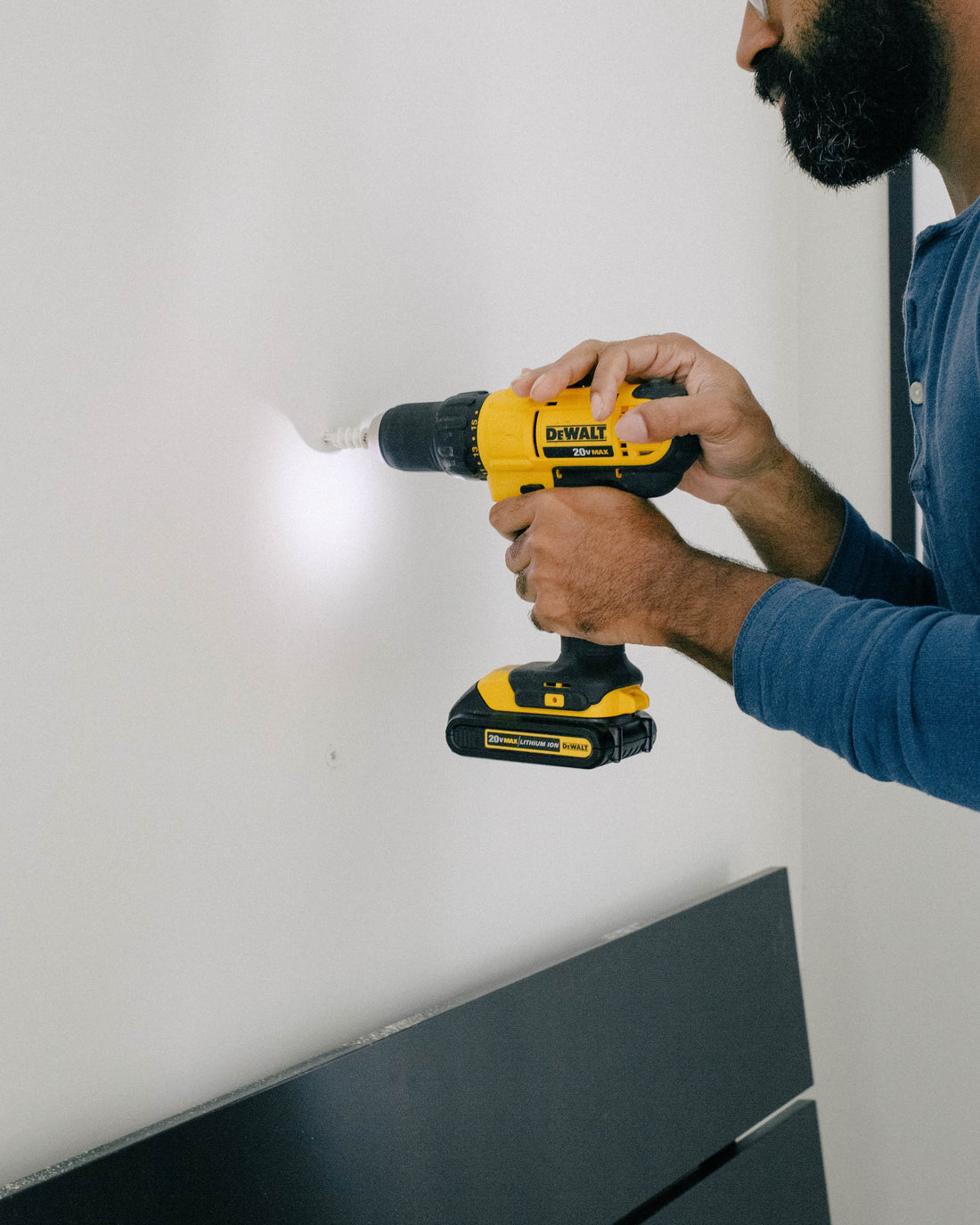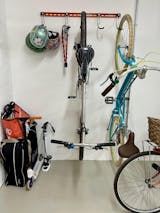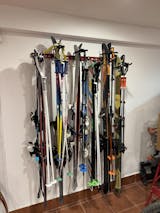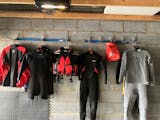
How to mount any thing on any wall : Your Ultimate Guide for Every Wall Type
Share
Embarking on the journey of mounting things on the wall can be both exciting and challenging, especially when faced with a myriad of wall types.
Whether you're updating your home, sorting out your garage, or organizing your shed, knowing how to mount anything on any type of wall is a valuable skill.
In this comprehensive guide, we'll delve into the intricacies of various wall types including concrete, stone, brick, breeze block, cinder block, plasterboard, drywall, timber, and shed walls.
We will explain the best fixings to use to fit anything, from an oil painting to the kitchen sink, to any wall type.
Equip yourself with the right tools, understand the fixings needed, and transform your space with confidence.
How to fix to Concrete, Stone, and Brick Walls: Building a Solid Foundation
For the robust and unyielding surfaces of concrete, stone, and brick, your key tool is a power drill with a masonry bit. Fischer (www.fischer.co.uk) offers a variety of anchors suitable for heavy-duty applications. Use high-quality wall plugs and screws designed specifically for these dense materials. Ensure precision by employing a bubble or laser level for accurate placement.
When it comes to mounting on concrete, stone, and brick walls, choosing the right fixings is crucial for secure and stable installations. Here's a detailed breakdown of different types of fixings along with examples from reputable manufacturers:
1. Sleeve Anchors:

- Description: Sleeve anchors are versatile and well-suited for solid materials like concrete and brick. They consist of a cylindrical metal sleeve with an expander cone and a nut at one end. As the nut tightens, the sleeve expands against the wall, providing a robust grip.
-
Example Manufacturer: Rawlplug
- Rawlplug's range of sleeve anchors includes options like the Rawlbolt Shield Anchor, designed for heavy-duty applications.
2. Expansion Anchors:

- Description: Similar to sleeve anchors, Expansion anchors are designed to spread and grip within the drilled hole. They work well in concrete and stone. The expansion mechanism can include wedges, toggles, or other configurations that ensure a tight fit.
-
Example Manufacturer: Hilti
- Hilti's Kwik Bolt Expansion Anchors are known for their reliability and strength in various concrete applications.
3. Concrete Screws:

- Description: Concrete screws are self-tapping screws specially designed for use in concrete. They eliminate the need for anchors and are easy to install. They create their own threads in the material as they are driven in.
-
Example Manufacturer: Simpson Strong-Tie
- Simpson Strong-Tie offers products like the Titen HD Concrete Screw, known for its high performance and ease of use.
4. Chemical Anchors:

- Description: Chemical anchors involve the use of resin or adhesive that bonds with the material, providing exceptional strength. It's a bit like gluing a bolt into a hole. These are ideal for both cracked and non-cracked concrete.
-
Example Manufacturer: Fischer
- Fischer's FIS V Chemical Anchor is a popular choice, offering excellent load-bearing capacity and durability.
5. Drop-In Anchors:

- Description: Drop-in anchors are set into pre-drilled holes in concrete or stone. They consist of a threaded shell and a setting tool is used to drive an internal plug, expanding the anchor within the hole.
-
Example Manufacturer: Red Head
- Red Head's Drop-In Anchors are well-regarded for their ease of use and reliability.
6. Concrete Wedge Anchors:

- Description: Wedge anchors are almost identical to sleeve and expansion anchors. They feature a metal shaft with a wedge-shaped end. As the nut is tightened, the wedge expands, providing a secure hold. They are suitable for both concrete and brick.
-
Example Manufacturer: ITW Ramset
- The Ramset Trubolt Wedge Anchor is a widely used product, known for its strength and durability.
It's important to follow the manufacturer's guidelines and recommendations when selecting and installing fixings to ensure a safe and reliable mounting solution. Always use appropriate personal protective equipment and tools when working with these materials.
How to fix to Breeze Block and Cinder Block Walls: Navigating Porous Terrain
It's worth noting that some very lightweight block walls, like aerated block or aircrete, require even more specialist fixings. All the ones mentioned here are likely to pull out of very soft material. Often the solution will be to bond (glue) a larger strip or sheet of wood to the wall and fix to that with wood screws (see below).
Breeze block and cinder block walls present a porous challenge. However, many of the solutions for concrete, stone and brick walls will also work in breeze block or cinder block walls.
Opt for anchors that can grip firmly into the porous surface. Rawlplug (www.rawlplug.com) provides insights into sleeve anchors or expansion anchors that suit these materials. Choose anchors that expand within the block for maximum stability.
When dealing with breeze block, cinder block, or hollow block walls, it's essential to choose fixings specifically designed for these porous and often less dense materials. Here's an explanation of different types of fixings along with examples from reputable manufacturers:
1. Plastic Wall Plugs:

- Description: Plastic wall plugs are common fixings used in hollow or porous blocks. They are inserted into pre-drilled holes and expand when a screw is driven into them, providing a secure anchor point.
-
Example Manufacturer: TOGGLER
- TOGGLER's SnapSkru Self-Drilling Drywall Anchors are versatile and suitable for various hollow wall applications.
2. Toggle Bolts:

- Description: Toggle bolts consist of a bolt threaded through a spring-loaded wing. The wings fold flat to insert through a pre-drilled hole and then expand inside the wall when the bolt is tightened. They are suitable for hollow or cavity walls.
-
Example Manufacturer: Hillman
- Hillman's Toggle Bolts are reliable and come in various sizes to accommodate different wall thicknesses.
3. Expansion Anchors:

- Description: Expansion anchors are suitable for cinder block and similar materials. They feature a design that expands once inserted into the wall, creating a secure hold.
-
Example Manufacturer: Rawlplug
- Rawlplug's Cavity Fixings are designed for hollow materials and provide reliable support for various applications.
4. Spring Toggle Fixings:

- Description: Spring toggle fixings, also known as toggle fixings,consist of a metal toggle that springs open once inserted into a pre-drilled hole. This type of fixing is suitable for hollow or cavity walls.
-
Example Manufacturer: ForgeFix
- ForgeFix's Spring Toggle Fixings are known for their strength and ease of use in hollow block applications.
5. Hollow Wall Anchors:

- Description: Hollow wall anchors are specifically designed for use in hollow blocks. They consist of a screw that expands a sleeve or wings once inserted into the wall, providing a secure hold.
-
Example Manufacturer: Simpson Strong-Tie
- Simpson Strong-Tie's Hollow-Set Drop-In Anchor is designed for use in hollow concrete block and provides reliable performance.
When working with breeze block, cinder block, or hollow block walls, it's crucial to choose fixings that are explicitly designed for these materials. Always follow the manufacturer's guidelines for installation, and ensure the selected fixings match the thickness and composition of the wall.
How to fix to Plasterboard and Drywall: Nailing the Right Approach
Dealing with the delicate composition of plasterboard or drywall is probably the most difficult medium to fix to. This risks are spinning fixings, rounded holes and the whole fixing pulling itself through the plasterboard.
A lot of the fixings above will work in plasterboard or drywall. However, it's very important to distribute weight evenly across the surface to avoid damage. Even with 'winged' fixings it is possible to pull one or more fixings through the plasterboard.
There is also a risk with a lot of these type of fastener that the 'wings' will spin behind the plasterboard (making it impossible the tighten the screw or bolt) or the whole thing will spin in the plasterboard itself.
A good solution is to use a stud finder (or look for nails in the skirting board) to locate the wooden studs behind the plasterboard and fix into these.
This is especially important if you only have one or two fixing points. If you have a longer item to fix, that may span one or two of these studs, always try to fix into these with long screws in addition to using any hollow wall fixings.
Fixings for plasterboard, drywall, and hollow walls come in various types, each designed for specific applications and weight-bearing capacities. Here's an overview of different types, including examples from the mentioned manufacturers:
1. Plastic Wall Plugs:

- Description: Plastic wall plugs are common fixings for plasterboard and drywall. They are typically made of nylon or other durable plastics and are inserted into pre-drilled holes. When a screw is driven into them, the plug expands, creating a secure anchor point.
-
Examples:
- Fischer: S Plug
- Rawlplug: Plastic Wall Plugs
- Plasplugs: All Fit Plus
2. Toggle Bolts:

- Description: Toggle bolts consist of a threaded bolt and a spring-loaded wing. The wings fold flat to insert through a pre-drilled hole, and then they expand inside the wall when the bolt is tightened. They are suitable for hollow or cavity walls and offer high load-bearing capacity.
-
Examples:
- Gripit: Gripit Yellow
- Fischer: Duopower
3. Hollow Wall Anchors:

- Description: Hollow wall anchors consist of a screw that expands a sleeve or wings once inserted into the wall. They are designed for use in hollow walls like plasterboard, providing a secure hold.
-
Examples:
- Rawlplug: Hollow Wall Anchor
- Geefix: Geefix
4. Self-Drilling Anchors:

- Description: Metal or plastic self-drilling anchors have a sharp tip that allows them to be easily drilled directly into the drywall. Once inserted, they provide a sturdy anchor point for screws.
-
Examples:
- Fischer: Metal Self-Drilling Anchors
- Rawlplug: Metal Self-Drilling Anchors
5. Duck Foot Anchors:

- Description: Duck foot anchors are designed to spread behind the plasterboard, providing a larger surface area for support. They are suitable for heavier loads.
-
Examples:
- Gripit: Gripit Red
6. Umbrella Style Fixings:

- Description: Umbrella-style fixings have a head that opens behind the plasterboard. They are designed for light to medium loads.
-
Examples:
- Fischer: Umbrella Fixings
Manufacturer Websites:
- Fischer: fischer.co.uk
- Plasplugs: plasplugs.com
- Gripit: gripitfixings.co.uk
- Rawlplug: rawlplug.com
- Geefix: geefix.com
When using fixings, always follow the manufacturer's guidelines for installation, ensuring the selected fixings match the weight and type of object you are mounting.
How to fix to Timber Walls: Embracing the Woodwork

When mounting on timber walls, screws directly into the wood provide a sturdy and reliable solution. Locate the studs using a stud finder, if they are not visible, to ensure a secure grip.
Always drill a pilot hole first and make sure it is smaller than the diameter of screw you plan to use. You should aim for the diameter to be no bigger than the diameter of the wood screw at the bottom of the 'V' in the threads.

Timber walls offer a straightforward and robust mounting surface. Consider the thickness and density of the wood to choose the appropriate screw length. If you can't use very long screws, try to use more of them if you can.
How to fix to Shed Walls: Tackling Outdoor Challenges
Shed walls often comprise a mix of materials, and can be damp thus requiring exterior-grade anchors and screws. Screwfix (www.screwfix.com) offers a range of solutions for outdoor applications. Ensure your mounts withstand the elements for durable indoor or outdoor installations.

Be careful when drilling into a shed wall and only fix to the thicker framework of the shed. If these are not in the right place, or are not long enough, you can add additional battens over the top of, or in-between the existing framework.
Think about the length of the screws and make sure they will not go right through the frame and outer wall timbers thus penetrating the shed.
Never fix the shiplap timbers that make up the outer wall of the shed as these fixings may penetrate or split the wall and let in moisture.
Conclusion: Transforming Walls, One Mount at a Time
Congratulations! You've unlocked the secrets of mounting on various wall types. Armed with the right tools and fixings, you can confidently transform any space. Whether it's displaying art, organizing tools, or creating a functional workspace, your walls are now ready to bear the weight of your vision.

Lots of the fixings that are available are suitable for more than one type of wall, which makes choosing the right one even more difficult. Make sure you double check with the manufacturer that the type of fitting you plan to use is suitable for your wall. We hope this guide has helped you ask the right questions.
How to mount sports and leisure equipment on the walls
If you find yourself drowning in sports and leisure gear but lacking the space to keep it all organized, GearHooks might just be the solution you've been searching for.
This innovative system uses a galvanized steel rail and individual hooks, offering a bespoke storage solution for various types of equipment. Each wall mounted rack is just 1 metre wide but has specially designed hooks that can store just one thing (like a bike) or many more (like garden tools) on each hook. With up to 8 hooks per rack, that means you can store 5 bikes, 25 ukuleles, 30 garden tools or more, in just 1 metre of wall space.
The beauty lies in its simplicity – easily and quickly mount separate hooks or the rail to your wall, and you're all set. Crafted from durable galvanized steel and powder-coated for versatility, these products are suitable for both indoor and outdoor use, making them a perfect fit for your house, garage, or shed.
Designed and made in the UK, GearHooks takes pride in providing a lifetime guarantee with each product, ensuring a lifetime of organized bliss.
Here's a quick explanation of just some of the things that you can easily store on the walls to save floor space and really organise all your gear:
-
How to wall mount Bicycles:
-
Bicycles can be wall mounted by hanging them on individual hooks fixed directly into the wall or on a hook and rail system for multiple bikes.
-
There are hooks and racks for every cyclist, whether you're into road biking, mountain biking (MTB), or cruising on an electric bike (e-bike). The specialised bike hooks securely cradle your two-wheelers, keeping them safely off the floor and easily accessible.

- How to wall mount Garden Tools:
- Garden tools can be mounted on individual hooks but these will quickly cover the walls. A solution that will save space is to use a garden tool rack that can hold several tools on each hook.
- Shovels, spades, forks and other hand tools as well as heavy tools like chainsaws and hedge trimmers find a tidy home on the wall. No more stumbling over gardening gear in the shed – the robust hooks can handle the weight, keeping your tools neatly organized and easily reachable. The tools you use most often will naturally migrate to the front of the rack.

-
How to wall mount Guitars:
-
Guitars can be mounted on individual hooks fixed directly to the wall but if you have a lot of guitars to mount it will mean a lot of holes to drill. Another option is to use guitar hooks that will each hold more than one guitar.
-
Perfect for home studios or any space where multiple guitars need efficient storage, these hooks keep your instruments both secure and stylishly displayed. Each hook can hold 3 or more guitars so you save lots of space and only need to drill 3 holes! They are super-strong too and will hold multiple acoustic guitars or solid body electric and bass guitars.

-
How to wall mount Ukuleles:
-
Ukuleles can be wall mounted on a specially designed hooks and racks that will hold multiple ukuleles. This will save space and allow a whole class set of ukuleles to be stored in a very small space.
-
Schools and colleges looking to keep ukuleles organized will find this solution especially suited to their needs. The compact yet sturdy design ensures that musical instruments are stored securely, making the most of limited storage space. Each hook can hold up to 5 ukuleles and each rack can have 3 or 5 hooks. That means 15 or 25 ukuleles can be stored on each 1 metre long rack. If you mount racks one above the other you can fit 50 or even 75 ukuleles in just 1 metre of wall space.

-
How to wall mount Golf Bags and Trolleys:
-
Golf bags and trolleys can be stood on purpose made racks but a wall mounted rack will get them off the ground, away from damp and vermin.
-
Golf enthusiasts can benefit from hooks designed for golf bags and trolleys. Keep your golf equipment neatly organized and off the ground, making your next tee time a breeze.

-
How to wall mount Skis:
-
Skis should be mounted on hooks or racks that get the ski tips off the floor so they can drip dry and air can circulate freely to avoid delamination or rusty edges.
-
Whether you're a seasoned skier or a casual enthusiast, safely store your skis, poles, and helmets with specially designed hooks, keeping your winter sports gear easily accessible yet out of the way during the off-season.

-
How to wall mount Snowboards:
-
Like skis, snowboards should be mounted on hooks or racks that get the snowboard off the floor so it can drip dry and air can circulate freely to avoid delamination or rusty edges.
-
These hooks offer tailored storage for snowboards, providing a smart solution that keeps your gear off the floor and ready for action.

-
How to wall mount Water Sports Equipment:
-
Any water sports equipment that has been used in salty or dirty water should be rinsed with clean water before storing it away. It should be hung somewhere to drip dry and stored where air can continue to circulate to avoid mould or rust.
-
From wetsuits, buoyancy aids and paddles to inflatables like stand-up paddleboards or canoes, and even diving equipment, these racks ensure your water sports gear is neatly organised and ready for your next aquatic adventure.

-
How to wall mount Skateboards:
-
Skateboards can be hung on individual wall hooks or on a wall mounted rack that will stack them closer together to save space. Most racks will allow you to see the graphics on the board so they can be displayed effectively.
-
Skateboard enthusiasts can use a versatile skateboard rack designed for different types of skateboards, ensuring a snug fit and a clutter-free space.

-
How to wall mount Climbing Gear:
-
Climbing gear like ropes, harnesses, helmets and smaller equipment like carabiners, can be stored in plastic boxes but this can make things hard to find. Anything that is damp will go mouldy or rust in a sealed box. A wall mounted climbing gear rack will display all the gear making it easier to find and to put away again whilst ensuring air can circulate around everything.
-
Ropes, harnesses, helmets, carabiners – climbing gear comes with a lot of accessories. These climbing gear racks provide a systematic solution to keep everything in its place, ensuring your climbing equipment is always ready for your next adventure.

-
How to wall mount Other Sports Equipment:
-
Almost any kind of sports equipment can be wall mounted on hooks or on a rack. Smaller bits and pieces may need to be put into bags and then hung on wall mounted hooks.
-
Tennis rackets, hockey sticks, kit bags – whatever your sport, there is a hook or a rack for them. Keep your sports equipment tidy, accessible, and proudly on display with these versatile hooks.

Gearhooks are not just about hooks and racks; it's a lifestyle solution for those seeking an organized, clutter-free environment for their beloved sports and leisure gear.
With Gearhooks, your gear is not just stored; it's showcased with pride, easily accessible, and neatly displayed. Say goodbye to clutter and hello to a well-organized space.





